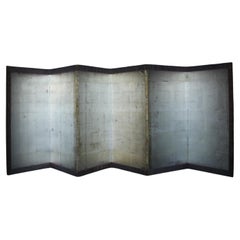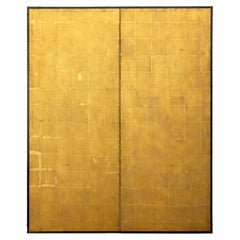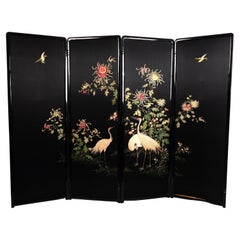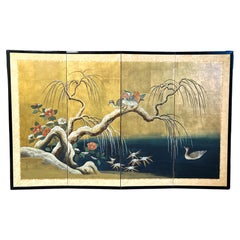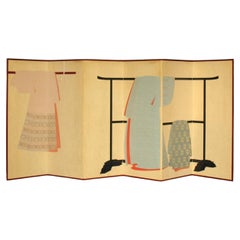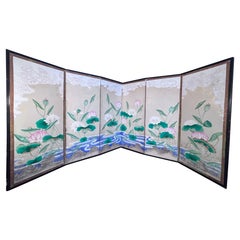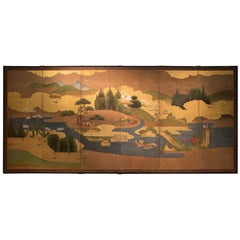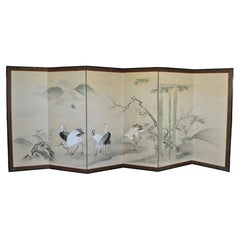Japanese Antique Byobu
20th Century Japanese Paintings and Screens
Paper
Antique Late 19th Century Japanese Paintings and Screens
Paper
Early 20th Century Japanese Screens and Room Dividers
Gold Leaf
Antique Early 1900s Japanese Meiji Paintings and Screens
Silk, Lacquer
Antique Mid-19th Century Japanese Edo Paintings and Screens
Gold Leaf
Early 20th Century Meiji Paintings and Screens
Metal, Gold Leaf
20th Century Paintings and Screens
Paper
Antique 19th Century Japanese Meiji Paintings and Screens
Gold Leaf
Recent Sales
Antique Late 19th Century Japanese Meiji Paintings and Screens
Paper
20th Century Paintings and Screens
Silk
Vintage 1920s Japanese Japonisme Paintings and Screens
Antique Late 19th Century Japanese Meiji Paintings and Screens
Lacquer
Antique Late 19th Century Japanese Meiji Paintings and Screens
Paper
Early 20th Century Chinese Chinese Export Paintings and Screens
Metal, Metallic Thread
Antique 19th Century Japanese Screens and Room Dividers
Antique Late 19th Century Paintings and Screens
Wood
Antique Early 19th Century Japanese Edo Paintings
Paper
Antique Late 19th Century Japanese Meiji Paintings and Screens
Lacquer
Antique Late 19th Century Japanese Meiji Paintings and Screens
Lacquer
Vintage 1930s Japanese Showa Paintings and Screens
Gold Leaf
Early 20th Century Japanese Taisho Paintings and Screens
Paper
Vintage 1920s Japanese Primitive Screens and Room Dividers
Wood, Cedar
Early 20th Century Japanese Taisho Furniture
Silk
Vintage 1920s Japanese Primitive Screens and Room Dividers
Wood, Cedar
Antique 19th Century Japanese Edo Sculptures and Carvings
Wood, Paper
Early 20th Century Japanese Art Deco Decorative Art
Antique 1880s Japanese Paintings and Screens
Paper
Antique 19th Century Japanese Screens and Room Dividers
People Also Browsed
2010s Austrian Jugendstil Wall Lights and Sconces
Brass
21st Century and Contemporary European Neoclassical Benches
Iron
2010s South African Minimalist Pedestals
Hardwood
2010s South African Minimalist Pedestals
Wood, Poplar, Burl
21st Century and Contemporary Mexican Mid-Century Modern Table Lamps
Wood, Fabric, Linen, Fiberglass
Vintage 1950s Austrian Art Nouveau Side Chairs
Fabric, Hardwood, Lacquer
Antique Late 19th Century Japanese Meiji Furniture
Wood
Mid-20th Century Japanese Antiquities
Wood
Antique Late 19th Century Japanese Antiquities
Wood
Antique 19th Century Japanese Meiji Paintings and Screens
Brass
20th Century Asian Paintings and Screens
Paper
Vintage 1920s Danish Scandinavian Modern Bookcases
Mahogany
2010s Austrian Jugendstil Chandeliers and Pendants
Silk
2010s Italian Modern Chandeliers and Pendants
Metal, Brass
Early 20th Century Meiji Coffee and Cocktail Tables
Wood
Antique Late 19th Century Japanese Edo Furniture
Wood
Japanese Antique Byobu For Sale on 1stDibs
How Much is a Japanese Antique Byobu?
Finding the Right Paintings-screens for You
Traditional Asian paintings were often created on scrolls and folding screens. Artisans made screens that could be folded up or spread out by connecting several panels using hinges. Today, antique Asian folding screens and paintings are sophisticated decorative accents that can serve as makeshift partitions to ensure privacy.
The original folding screens were created by Chinese artists. The earliest record of screens comes from the 2nd century B.C., and surviving examples date back to the Ming dynasty. Chinese painting utilizes many of the same tools as calligraphy — these screens were crafted from wood with painted panels featuring striking art or calligraphy that told cultural stories or represented nature and life in the area.
The practice was introduced to Japan, where paintings for screens were made on paper and silk, in the 8th century. These paintings frequently feature subjects such as landscapes, animals, flowers and Buddhist religious themes. Along with screens for tea ceremonies and dance backgrounds, there were screens for use in Shinto and Buddhist temples.
In the 17th century, screens began to be imported to Europe where their popularity grew. Coco Chanel famously collected Coromandel folding screens.
Traditional Asian paintings can make a tasteful addition to any wall, and screens can be used as decoration or, in the case of larger iterations, as an aesthetic way to divide a large room. Browse the selection of antique Asian paintings and screens from a variety of styles and eras on 1stDibs.
- 1stDibs ExpertAugust 8, 2024To tell if your Japanese pottery is antique, look for markings, which usually appear on the bottoms of pieces. If you see the word "Nippon," your piece was likely produced between 1891 and 1921, making it an antique. Pieces marked with the words "made in occupied Japan" originated between 1945 and 1952 and are vintage, based on their age. A "made in Japan" marking may indicate a vintage or contemporary piece. If you don't see any of these markings, consult trusted online resources to get a rough idea of when your pottery was produced. Any piece that dates back 100 years or more is antique. Should you encounter difficulty with the dating process, a certified appraiser or knowledgeable antique dealer can assist you. On 1stDibs, shop a variety of Japanese pottery.
Read More
Symbols of Happiness and Rebirth Adorn This Japanese Satsuma Bowl
Decorated with white cranes and the sought-after thousand-butterflies motif, the Meiji-period vessel offers both a celebration of traditional aesthetics and a clear reflection of the era’s appetite for exquisite export pieces.
Chicago’s Pagoda Red Has a Spirited Mix of Asian Antiques and Bold New Art
For 25 years, gallerist Betsy Nathan has leveraged her keen eye and key connections to bring a unique selection of rare finds to the market.
In L.A., Gallerist JF Chen Has Long Championed Eclectic Blue-Chip Design
Now working alongside his daughter Bianca, dealer Joel Chen has presented a most covetable array of antiques, art and contemporary creations for more than 40 years.
12 Calming Spaces Inspired by Japanese Design
From cherry-blossom-adorned walls paired with glamorous lighting to wood-paneled ceilings above checkerboard-patterned chairs, these 12 spaces seamlessly blend Eastern and Western aesthetics.
Rodrigo Rivero Lake’s Mexico City Showroom Is a Museum-Worthy Trove of Spanish Colonial and Asian Antiques
The dealer and curator has spent the past 50 years amassing a collection of exceptional art, furniture and architectural elements that trace the cultural influence of the Spanish empire from Europe to the Americas and beyond.
16 Refined Asian-Inspired Interiors
These spaces exemplify how Eastern elements elevate a home's decor.
